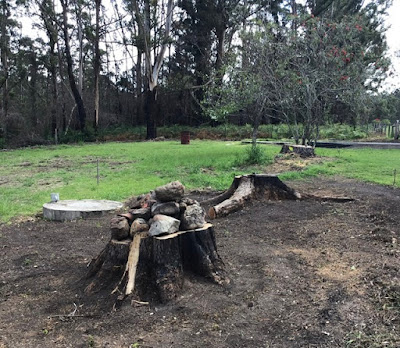Both tree removal projects (bushfire and storm damaged) left a considerable mess.
Heavy machinery and lawn/grass don’t mix especially in the latter removal case where the ground was still very wet from the storm that brought those trees down.
The contractor had removed or burnt, on site, all of the large timber but some biggish surface roots and branch remnants remained.
If we were going to level off, repair and reseed the areas affected, all this debris had to go.
So it was barrow load after barrow load onto the burn pile that had been kept alight for 10 days.
Then our council invoked an early bushfire season date and we could no longer burn. Sure, you can get a permit but the hoops you have to jump through getting it and complying with conditions are not worth the trouble.
So we started a new pile that will be burnt during winter next year.
Then it was a matter of filling in holes and levelling out the various areas and reducing some slopes to make future mowing easier and safer. Luckily due to the excavations for the new shed, we had a big pile of good sandy loam top soil to do that job. It should provide an excellent friable bed for the lawn seed to germinate and grow quickly.
Our soil has a pH of around 4.5 ie. it’s acidic. The native grass in our area has obviously adapted to that over the millenniums but commercially available grass grows better in soil with pH 6.0 to 5.5. We had considered using turf (sod) from our native pasture but it was just too big a job to cut and re-lay.
So we limed the cleared areas at a rate 2kg/10m² to hopefully increase pH at least one unit. This is not a quick fix but a slow chemical process that will eventually pay dividends.
Once the preparation was done, it was time to sow.
We mixed the lawn seed (30g/m²) with the starter fertiliser (22g/m²) and distributed it over the finely raked soil bed in both directions, raked it in gently and then watered lightly.
We used a Hortico drought resistant blend with 38% Perennial Ryegrass, 27% Annual Ryegrass, 20% unhulled Couch, 8% Creeping Red Fescue and 7% Kentucky Bluegrass.
The starter fertiliser is a slow release type made especially for new lawns.
It will be interesting to see how this works out as I have never done this before. In a past life, I have only used rolls of turf for new lawns.
So with the removal of the southern house paddock fence and bushfire damaged trees, our backyard has doubled in size. This obviously means more mowing but easily done on the ride-on. The remaining large tree stumps will be a sculptural type feature. Grinding them out would have added substantially to our bill.
The removal of seven trees in total has altered our surroundings completely. Our outlook in two directions is now very different and more open.
We have decided, after the initial ‘shock’, that is not such a bad thing.


























1 comment:
You say "WE" my darling, but mostly it's been YOU. You're the BOMB. xo
Post a Comment